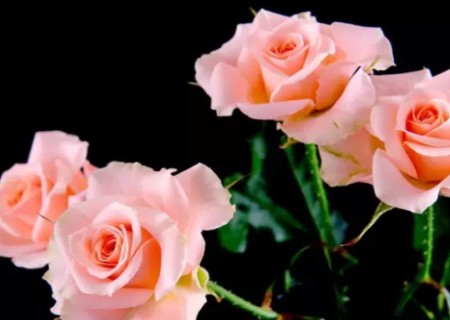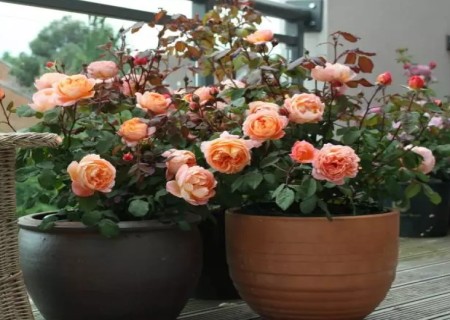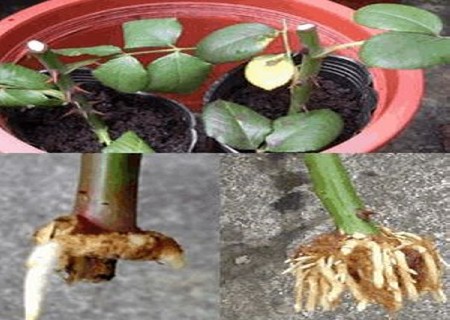Detailed explanation of the method of water insertion and propagation of Chinese rose
Rose, known as the queen of flowers, also known as "moon red", Rosaceae. Evergreen or semi-evergreen low shrub, flowering all year round, red, occasionally white, can be used as an ornamental plant, can be used as a medicinal plant, also known as rose.
The water insertion method is used in rose reproduction, and the survival rate is the highest in spring and autumn. The climate in spring and autumn is warm, and the water temperature is easy to be kept at about 15 ℃-25 ℃, which is the suitable temperature for cutting rooting. Too high or too low water temperature will affect the hairy root. The advantages of the water insertion method are: the method is simple, the survival rate is high, it is not limited by time, and it can be cut and inserted after the flowers are faded.

In the spring and autumn season, collect the branches that are healthy and full (Lignified). The 2-3 sections are cut into one section and cut off about 2 mm below the last section. The cut should be flat, preferably with a glass jar or a glass bottle with a larger caliber. You can also use an opaque shallow-bottomed porcelain jar. The container contains tap water with a depth of 6 cm. Then use a 1-2 cm thick foam block as a floating body, and the foam block uses a knife or iron nail to make a small hole, embed the finished scion, protrude 3-4 cm at the lower end, and place it in the outdoor semi-shade after entering the water.
In summer, because the water temperature is high, it should be placed in a shady place, or in a cool place with indoor ventilation. Late autumn temperature is low, in order to improve the water temperature, you can put it outside or indoors facing south to the sun, so that it can fully accept the sun. Water should be kept clean and fresh. Water should be added or changed every two or four days. The deterioration of the water quality will cause the cuttings to rot.
The water has been inserted for about 15 days, and if the branches soaked in water have formed a white healing shape, they will survive. If the branches are black and rotten, they are dead. After 30-40 days of water insertion, small white roots of different lengths are formed at the bottom of the branches, which can be taken out and cultivated at this time. Before cultivation, first determine the ground or potted plant, select the planting ground, and then insert a thick stick with chopsticks, plant the branches with roots, wrap them with coarse sand, fill the soil and water them thoroughly, and then cover them with plastic bags for about half a month to maintain humidity. Do not directly bask in the sun.
When the new buds grow 5ml 10cm, the plastic bags can be removed to receive light. 15Mel can blossom after 20 days. If the nutrient solution is added after rooting, it will become a water wall and grow and blossom in the water, which is very suitable for family cultivation and can be cultivated according to the conditions.
The water insertion method is used in rose reproduction, and the survival rate is very high. Now the method of water insertion propagation of rose is introduced to the friends who like rose for reference. The main points are as follows:
Cut a branch with three leaves, and the upper two leaves each retain two leaves. The lowermost leaf is cut from the petiole.
Then, use iron wire or other hard objects to pierce the foam board through a small hole, insert the branches through the foam board, and immerse the branches in water for about 1-3 cm.
Place the basin on the balcony or in the shade where there is scattered light. After about 20 days, transplant the long branches into a plastic cup filled with mud and place them in the shade or on the balcony with scattered light.
It is said that the survival rate of this breeding method can reach more than 98%. The method introduced by the flower friends is to transplant the seedlings with very fine soil, and then water the cup until the cup is full. I find it more convenient to use thin mud. The production of thin mud is very simple, yellow clay plus perlite, water and paste. When transplanting seedlings, we should also pay attention to not pulling out the seedlings with long roots from the foam board, but to break the foam board and take out the seedlings, so as to avoid breaking the tender roots. Plant it in muddy paste and put it in the shade of a tree.
A week later, when the mud in the cup turns into a semi-wet mud lump, you can cut the cup and transplant the soil into a flowerpot, so the twigs complete the adaptation process from the water environment to the soil environment, and a new rose is born.
There are many varieties of Chinese rose, which can blossom all the year round. It is a kind of flower plant that is widely liked by people. Rose flowers are often propagated by water insertion, which has the advantages of simple method, high survival rate, no time limit, and can be cut and inserted after flower fade. This article tells you what matters needing attention in rose aquaculture.
The method of water insertion and culture of rose is to cut off the residual flowers and let the flower branches grow for several days, waiting for the first axillary buds on the flower branches to grow stout and accumulate nutrients, then cut off the cuttings of 3 nodes, remove the petiole of the bottom, cut the bottom bud into a bevel, and immediately insert it into a bottle filled with clean water, and the cuttings can be inserted into the water.
1. In order to reduce the water evaporation of leaves, part of the leaves can be cut off.
2. In the dark environment, the rose incision is easy to grow new roots, so it is best to use brown bottles as culture containers. If you can't find a brown bottle, you can also wrap a layer of black plastic film on the ordinary glass bottle.
3, the bottle should be placed on the sunny windowsill or balcony, but can not accept the sun exposure. When the temperature is high, the water can be changed once a week.
4. When the young root grows to 1 cm or 2 cm long, it can be transplanted in the pot. Because the young root grows in water, in order to make it adapt to the environment, it is watered once a day at the beginning of transplanting, and then decreases gradually.
Time: 2019-06-09 Click:
- Prev

High pressure breeding method of rose
A wide variety of rose flowers bloom throughout the year, the color is extremely rich, such as red, white plain jade, yellow satin, purple still gemstone, bright color, colorful, is incomparable to many flowers. High pressure is one of the commonly used methods in the propagation of rose.
- Next

Ring peeling Cuttage technique of Rose-Diagram of Rose girdling Propagation
Ring peeling is ring peeling, that is, after peeling off the root, the nutrients on the trunk will not flow back to the root in autumn and winter. In the spring, the plants sprouted and the nutrients from the roots were transported upwards. By the time the wound peeled off last year healed, the flowers on the tree had already bloomed and the young fruit was ready. Ring peeling
Related
- Fuxing push coffee new agricultural production and marketing class: lack of small-scale processing plants
- Jujube rice field leisure farm deep ploughing Yilan for five years to create a space for organic food and play
- Nongyu Farm-A trial of organic papaya for brave women with advanced technology
- Four points for attention in the prevention and control of diseases and insect pests of edible fungi
- How to add nutrient solution to Edible Fungi
- Is there any good way to control edible fungus mites?
- Open Inoculation Technology of Edible Fungi
- Is there any clever way to use fertilizer for edible fungus in winter?
- What agents are used to kill the pathogens of edible fungi in the mushroom shed?
- Rapid drying of Edible Fungi

